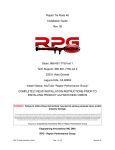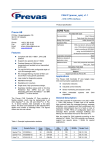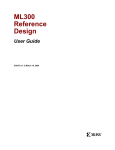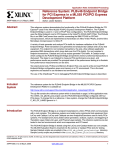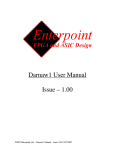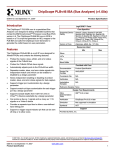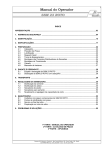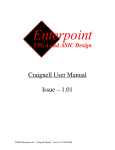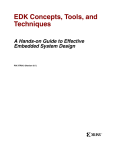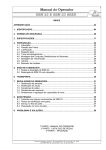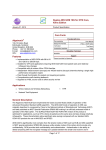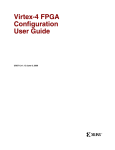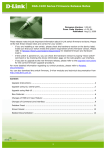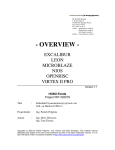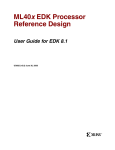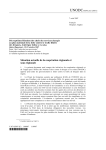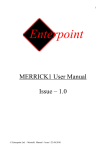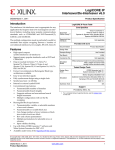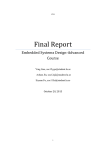Download CAN IP (precan_plb46), v1.0 - With PLB v4.6 interface Prevas AB
Transcript
CAN IP (precan_plb46), v1.0 - With PLB v4.6 interface Product Specification CORE Facts Prevas AB Provided with Core PO Box 4 (Legeringsgatan 18) SE-721 03 Västerås Sweden Phone: Fax: Email: URL: Documentation User’s Manual Data sheet (this document) Design File Formats +46 21 360 19 00 +46 21 360 19 29 [email protected] www.prevas.se VHDL Source RTL Constraint Files None Verification CAN protocol compliance tested, according to ISO16845, using the XA3S1600E ECU development board from Si-Gate Features Instantiation templates None Compliant with ISO 11898-1, CAN 2.0B protocol. Reference designs & None Supports bus speeds above 1 Mbit/s Additional Items application notes Xilinx XPS peripheral description files (.pao, .mpd) Overload frames on CAN bus are recognized and handled but not transmitted by this core Simulation Tool Used Modelsim v6.1c Support TX and RX FIFOs with configurable depth of 2 to 63 messages each. Support provided by Prevas AB High Prio TX Buffer Applications Optional High Prio RX buffer The Prevas CAN Controller IP core targets many CAN communication applications like: RX message filtering. Number of filters can be set from 0-2 by generic parameter. One dedicated filter for High prio RX buffer. Automotive networks Industrial control networks Loop mode for diagnostic purpose Maskable interrupts Sensor monitoring and actuator control Readable error counters Other embedded capabilities Single clock, fully synchronous design. Seamless interface (slave port) to PLB v4.6 bus for easy integration with Xilinx MicroBlazeTM and IBM PowerPCTM in Xilinx devices. The Prevas CAN Controller IP Core provides a flexible solution, which may be implemented in all Xilinx Spartan™-3, -3A, -3E and Virtex™-II, -II Pro, -4, -5 device families. See examples in the table below. The slice count depends on the selected FIFO depths and number of message filters. The figures shown are for a configuration with 1 RX filter, RX prio buffer enabled, RX FIFO depth of 16 messages and TX FIFO depth of 4 messages. systems with CAN General Description The CAN Controller IP implements to the ISO 118981, CAN 2.0B protocol. It takes care of all transfer layer protocol tasks like message framing, message arbitration, error signaling and fault confinement and automatic retransmission due to tx faults or loss of arbitration. TX/RX FIFOs of configurable depth and message filters provides message buffering and filtering and decreases the load on the local CPU. Max bus speed for CAN networks according to the standard is 1 Mbit/s. This CAN controller can however support bus speeds above 1 Mbit/s for special applications. Table 1: Example implementation statistics Family Example Device Fmax (MHz) Slices * IOBs (external) BRAM s Design Tools Spartan™-3x XC3S1600E-4 96 975 2 2 ISE 10.1.03i Virtex™-4 XC4VLX15-12 205 975 2 2 ISE 10.1.03i Virtex™-5 XC5VLX30-3 150 575 2 2 ISE 10.1.03i 1 Product Specification CAN Controller (precan_plb46), v1.0 Figure1. CAN Controller IP Block diagram Functional Description • The figure above shows a high level block diagram and the major data flow of the CAN Controller. The TX and RX signals should be connected to an external CAN transceiver chip. A description of the sub-modules follows. • • • IPIF The connection of the CAN controller to the PLB bus is provided by a PLBV46_SLAVE_SINGLE (IPIF) module from Xilinx. This block provides a seamless interface (slave port) to the PLB bus for easy integration of user peripherals with Xilinx TM TM MicroBlaze and IBM PowerPC in Xilinx devices. A preconfigured IPIF module is integrated together with the Prevas CAN IP. The IPIF module is configured to support the functions available in the CAN Controller.. CAN core The CAN core is responsible for all transfer layer functions of the CAN protocol and consist primarily of a control unit, bit-stream processor, error handler and bit synchronization unit. Control unit The control unit is supervisor of the other modules in the CAN core and handles the overall node behavior depending on the node state, i.e. if the node is in init mode, error active, error passive or bus off, and if the node is receiver or transmitter of the current message. Calculate CRC and append CRC bits to the outgoing message stream. Perform bus arbitration Monitor the transmitted bits to detect bit errors. Automatic retransmission of the message in the case of a transmission error or if arbitration was lost During reception of a message, similar tasks are performed in an opposite way. There are also several other error checks: • • • • Remove and check value of fixed form bits to detect form errors Remove stuff bits and check for stuffing errors Calculate CRC of the incoming message and compare with received CRC Acknowledge successfully received messages by transmitting a dominant bit in the ACK slot of the CAN frame. Error handler Any errors detected by the BSP are signaled to the error handler, which is responsible for fault confinement and transmission of error frames. It updates its transmit and receive error counters in accordance with the ISO 11898-1, CAN 2.0B standard and, based on the value of these counters, determines the error state of the controller; active, passive or bus off. Bit stream processor The bits stream processor (BSP) takes care of message data serialization and de-serialization, framing and format tasks. During transmission, these tasks are: • • Insert fixed form bits in the message frame. Insert stuff bits 2 Product Specification CAN Controller (precan_plb46), v1.0 Bit synchronization The bit synchronization module has the following functions: • • • • • • Clock pre-scaling. Synchronizing the CAN core to the traffic on the CAN bus. Place TX bits on the bus with the correct timing Calculate the sampling point and provide a sample clock to the rest of the CAN core. In loop mode, the core is “disconnected” from the CAN bus, i.e. only recessive bits are transmitted and the bits transmitted by this node is instead routed back to the receive input. Incoming data from the CAN bus is ignored. Bit error detection The synchronization process compensates for propagation delays and oscillator frequency differences between the transmitting and receiving nodes. Configuration and status registers The configuration and status registers is the interface for an external micro-controller. Refer to the user manual for description of the registers. All registers are 32-bit wide, addressed at word boundaries and represented in big-endian format (Bit 0 is MSB, bit 31 is LSB). TX/RX FIFO Separate storage buffers for transmit and receive message are provided in a FIFO structure. The depth of each buffer is individually configurable through generic parameters and may be from 2 to 63 messages each. High Prio Buffers In addition to the FIFOs, there are a High Prio TX buffer which can store one message. A message stored in this buffer will be transmitted as soon as the CAN bus is idle, bypassing any remaining messages in the TX FIFO. There is also an optional High Prio RX buffer (enabled with a generic parameter) This buffer can store one message. Any incoming message which matches the dedicated filter for this buffer is stored here. RX filters IDs of incoming messages are compared with userdefined ID acceptance masks. If there is a match, the message is stored in the RX buffer connected to the filter. If no match is found, the message is just acknowledged and then discarded. The number of acceptance filters for the RX FIFO is defined with a generic parameter which may be set from 0 to 2. The high prio RX buffer (if enabled) has a dedicated filter. If no acceptance filter is used, all successfully received messages are stored in the RX buffer. Signal Dir Description Bus2IP_Clk IN System clock (min 24 MHz) Bus2IP_Reset IN Active high reset Bus2IP_Addr[0:31] IN Address bus Bus2IP _Data IN Write data bus IN Byte enables (not used, all registers are accessed at word boundaries) IN Register read qualifiers IN Register write qualifiers OUT Read data bus IP2Bus_RdAck OUT Active high read transfer acknowledge IP2Bus_WrAck OUT Active high write transfer acknowledge IP2Bus_Error OUT Not used, tied to GND can_rx IN RX data from CAN transceiver [0:C_SLV_DWIDTH-1] Bus2IP _BE [0:C_SLV_DWIDTH/8-1] Bus2IP_RdCE User interface The user interface of the CAN controller uses naming conventions of the “user side” of the IPIF module. These signals provide a seamless interface to the IPIF module. Table 2 describes the signal interface. [0:C_NUM_REG-1] Bus2IP_WrCE [0:C_NUM_REG-1] IP2Bus_Data [0:C_SLV_DWIDTH-1] can_tx OUT TX data to CAN transceiver precan_irq OUT Interrupt line. Goes high when an irq is generated. Table 2: User interface signals 3 Product Specification CAN Controller (precan_plb46), v1.0 Design parameters A number of generic parameters can be used to tailor the design to specific application needs for optimum performance. The value of these parameters has some impact on the resource utilization of the IP, see table 1. Design Services Prevas also offers core integration, customisation and other design services. core Parameter Default Description C_RX_FIFO_DEPTH 4 The desired depth of the RX buffer in number of messages. Settings 2-63 are valid. C_TX_FIFO_DEPTH 4 The desired depth of the TX buffer in number of messages. Settings 2-63 are valid. C_NR_OF_FILTERS 1 The desired number of receive filters. Settings 0-2 are valid. C_RX_PRIO_BUFFER FALSE Enable/disable the RX High Prio buffer C_SLV_DWIDTH 32 Data bus width (Do not change this setting!) C_NUM_REG 32 The number of register selects within the address space (Do not change this setting!) Table 3: Core generic parameters Core Modifications More features may be added to the core at request and additional cost. Customers may also modify the RTL source code at own responsibility. Verification Methods The CAN Controller core’s functionality has been extensively tested in hardware, using the XA3S1600E ECU development board from Si-Gate. The functionality has also been verified in accordance with the "ISO16845:2004 Road vehicles - Controller area network (CAN) - Conformance Test Plan”. This compliance test has been performed by C&S Group, Germany. Ordering Information This product is available from Prevas AB under terms of the SignOnce IP License. See www.prevas.se for pricing or contact Prevas for additional information about this product. Prevas AB PO Box 4 (Legeringsgatan 18) SE-721 03 Västerås Sweden Phone: Fax: Email: URL: +46 21 360 19 00 +46 21 360 19 29 [email protected] www.prevas.se Prevas AB cores are purchased under a Licence Agreement, copies of which are available on request. Prevas AB retains the right to make changes to these specifications at any time, without notice. All trademarks, registered trademarks, or service marks are the property of their respective owners. Related Information Xilinx Programmable Logic For information on Xilinx programmable logic or development system software, contact your local Xilinx sales office, or: Xilinx, Inc. 2100 Logic Drive San Jose, CA 95124 Phone:+1 408-559-7778 URL: www.xilinx.com 4




